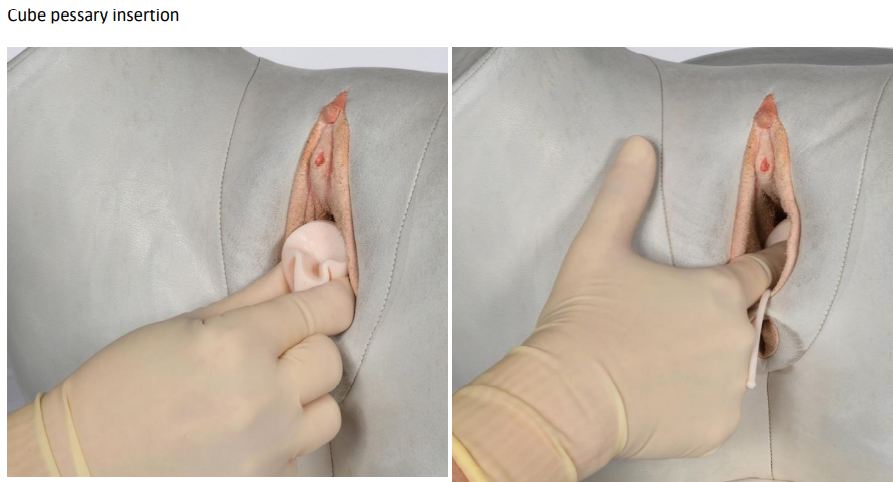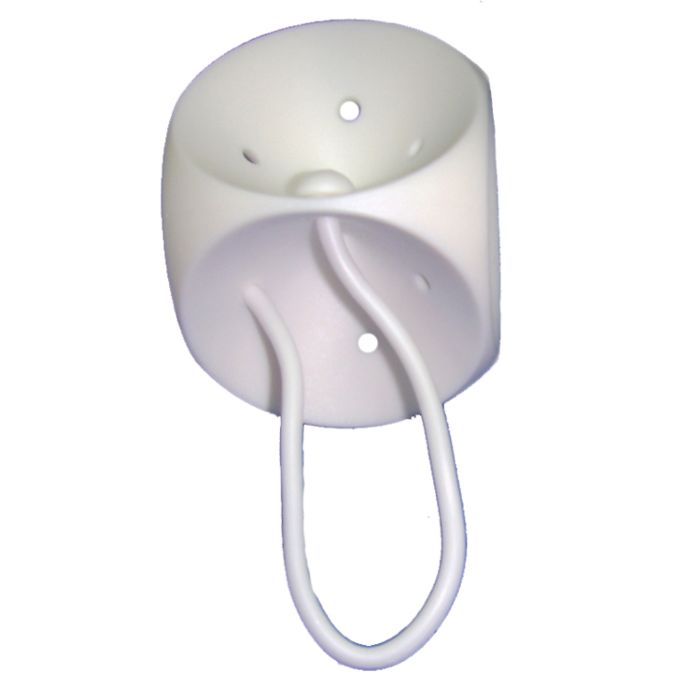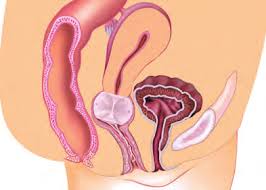The Cube pessary is made of a flexible silicone material that has six concave sides that suction to the walls of the vagina, which help it to remain in place.
How to insert a cube pessary:
Wash your hands and pessary with warm water and soap.
Find a position you feel most relaxed, comfortable, and able to reach your vaginal opening:
- Sitting on the edge of a chair, toilet or bed.
- Deep squat.
- Standing with a leg up. If you are right-handed, put your left foot up on the surface.
- Lying down with knees bent.
If your prolapse sits close to, or out of the vaginal opening, you need to push and reinsert the bulge up as high as you can.
Using your thumb and first 2 fingers of your dominant hand, compress the cube pessary as much as you can. Ensure the loop is facing downwards.
Lubricate the edge of the pessary that will enter your vagina first. Avoid getting lubricant on your hands or anywhere else on the pessary, as it can make it too slippery to insert.
Breathe in and out and relax your pelvic floor muscles.
Parting your labia with your non-dominant hand.
Insert the compressed cube at the opening with downward pressure on your back vaginal wall.
Once inserted past the vaginal opening, release the pessary and push it into your upper vagina with your index finger.
You may need to fold the loop up and hook it into the vaginal space.

How to remove a cube pessary:
Wash and dry your hands.
Find a position you feel most relaxed, comfortable, and able to reach your vaginal opening:
- Sitting on the edge of a chair, toilet or bed.
- Deep squat.
- Standing with a leg up. If you are right handed, put your left foot up on the surface.
- Lying down with knees bent.
Use the loop to locate the pessary (middle finger works best) but DO NOT use it to pull down on.
Use your index finger to locate a side of the cube, and gently hook tip of finger on the top surface to break the suction.
Now gently zig-zag or “unroll” the cube towards the vaginal opening, continuing to break the suction.
Lastly, grasp and compress the edges of the cube with your thumb and fingers to remove from the vaginal opening.
Note: Do not panic if you are having difficulty removing the pessary. Try a different position, and bear down by “straining” or coughing. If you do not succeed, then contact your physio or GP who will be able to help you. If you cannot contact your physio or GP and are in pain or cannot empty your bladder and bowel you can go to your nearest hospital accident and emergency and tell them that you have a vaginal pessary that may be causing a problem.
Different positions for insertion and removal
How to clean the Cube pessary:
A cube pessary needs to be removed DAILY and left out overnight. This allows the vaginal walls to rest. Most women will reinsert the pessary again in the morning.
Once you have removed the pessary:
Wash with mild soapy water by rubbing pessary with your fingers or a soft brush.
Clean drainage holes and around the loop with a pipe cleaner.
Rinse the pessary well with water.
Dry the pessary completely with a clean paper towel or clean cloth and allow to air dry.
Check the pessary for any obvious cracks or signs of wear.
Store in a dry, safe place (plastic container or wrapped in a clean cloth).
Discolouration of the pessary often occurs and is not harmful.
When should I have the pessary checked or changed?
After the initial fitting, you should attend a review appointment at:
- 1-2 weeks: to review your ability to remove and insert and to check if the pessary is comfortable. It is also important to check for good bladder and bowel emptying.
- 3-4 months: to check that the vaginal mucosa is tolerating the regular pessary wearing.
- 1 year: this annual review should be with your GP or gynaecologist so they can check the health of your vaginal walls via speculum exam. You will also need to see your pessary physiotherapist for a replacement pessary and to check if your pessary type or size is still appropriate.
If you have any concerns about the fit of your pessary, please contact your physiotherapist to arrange a review.
Do I need to use vaginal oestrogen with the pessary?
If you have been prescribed vaginal oestrogen, you will need to continue using it as maintenance (usually 1-2 times/week as per your GP's recommendation) whilst using the pessary. This can improve the condition of the vaginal walls and may protect them from injury, reducing your risk of infection or ulcers.
Can I have sex whilst wearing the pessary?
No. A cube pessary will need to be removed prior to having penetrative intercourse, and then reinserted again afterwards.
How do I manage my period whilst wearing the pessary?
A cube pessary does have drainage holes, but allows for limited menstrual flow so you will need to remove during your heavier menstrual flow days or wear for short durations, eg for exercise. Sanitary pads or period underwear will be your best menstrual protection. You will need to remove the cube in order to use tampons.




